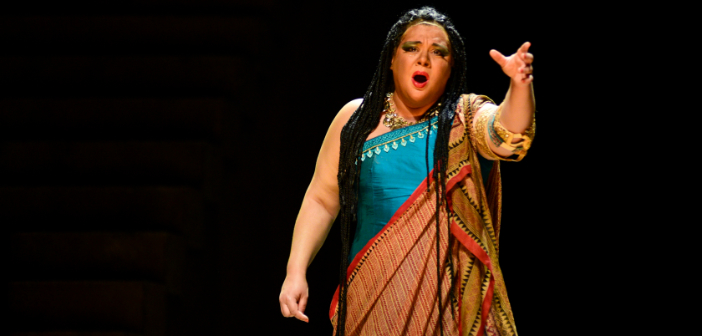Returning to the Opéra de Montréal stage for the first time in a decade, Verdi’s Aida opened last night in a flash of grandeur.
Set in a fictional pharaonic Egypt brought to life by the Romantic imagination, Aida is a classic story of forbidden love, jealousy, and revenge. Given the relative risk of Another Brick in the Wall (March 2017), a new commission from first-time opera composer Julien Bilodeau based on Pink Floyd’s seminal album The Wall, it seems judicious to open the season with this well-loved standard.
While it remains secure in the operatic canon, Opéra de Montréal’s production reminded us why Aida deserves that esteem. What might be considered a rather thin plot was spun out elegantly with a visual feast, with elaborate sets and costumes designed by Claude Girard and Bernard Uzan. Though recycled from their production 10 years ago, they looked new under the dappled golden lighting, as designed by Éric Champoux.
The two lovers, captured Ethiopian slave-princess Aida and Egyptian military commander Radames – played by Russian soprano Anna Markarova and Bulgarian tenor Kamen Chanev – were graceful but subdued. Markarova, in particular, contended with a pinched upper range, especially in Acts III and IV.
Jealous Amneris, played by Russian mezzo-soprano Olesya Petrova, arguably stole the show, giving the widest range of character in the closing scenes as she overhears Radames’s trial and condemnation for treason and ultimately appeals to the gods to permit rest for the entombed lovers. The final Slavic member of the cast was Belarusian bass Anatoli Sivko as the King of Egypt, who gave a fine and polished performance.
Canadians Gregory Dahl (Aida’s father, Amonasro), Phillip Ens (Ramfis), and Atelier lyrique artists Keven Geddes (Messenger) and Myriam Leblanc (High Priestess) made strong additions. Leblanc was particularly luminous in the crowd scenes from the first half of the opera.
The staging by director François Racine was conservative but anything but lifeless. Choreographer Noëlle-Émile Desbiens and Chorus Master Claude Webster deserve special recognition for coordinating the visual and sonic complexity of the crowd scenes; of course, only possible with the reliable hand of conductor Paul Nadler leading the Orchestre Métropolitain.
Though no doubt in the works for a long time, Aida proved to be a success for the Opéra de Montréal’s new General Director, Patrick Corrigan, who steps in from his previous position with the Pacific Opera Victoria. Given the busy five-production season that includes Don Giovanni, Dialogues des carmélites, La Bohème, and Another Brick in the Wall, it will be interesting to see what types of risks the company is willing to make under the opportunity of new leadership. Time will tell.
» Three performances remain, September 20, 22, and 24, Salle Wilfrid-Pelletier, 7:30PM. http://www.operademontreal.com/en/shows/aida
















